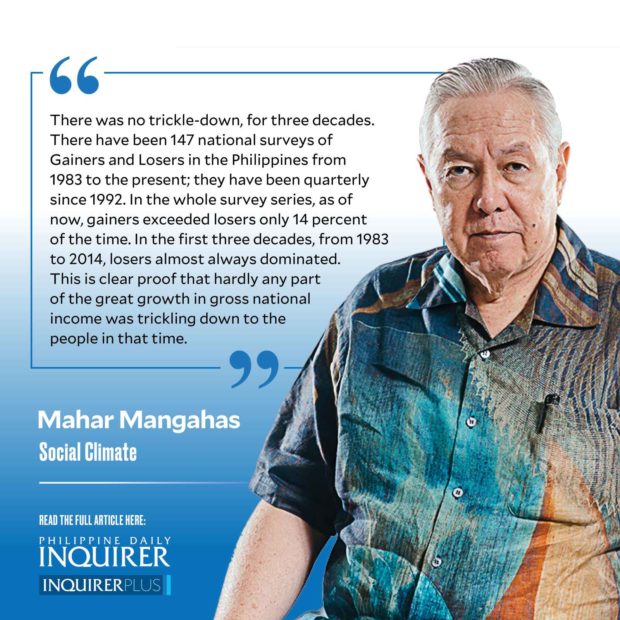Net Gainers reach +8
As 2022 closed, after three pandemic years, the people getting better off have finally outnumbered those getting worse off. In the SWS December 2022 survey, there were 34 percent of Filipino adults saying their quality of life (uri ng pamumuhay) improved in the past 12 months; this was 8 points more than the 26 percent saying it had worsened (“Fourth Quarter 2022 Social Weather Survey: Gainers minus Losers at +8,” www.sws.org.ph, 1/25/2023).
Together, the gainers and the losers were 60 percent of the national total of adults. The balance consisted of 39 percent, whose QOL was the same as a year ago, plus half a percent who couldn’t answer. Subtracting the losers from the gainers is a way to summarize the results by a single number, called Net Gainers.
Article continues after this advertisementThis indicator is about progress, not status. In effect, it asks how many people are on escalators going up, how many are on escalators going down, and how many are staying put. It doesn’t ask on what floors the people are. It doesn’t try to quantify how much the gainers gained or how much the losers lost. It’s simply democratic (“Count people, not money,” Inquirer.net, 9/24/22).
As usual, those of higher status are making more progress. Looking across the four SWS survey areas, the new national Net Gainers score of +8 is made up of +18 in the National Capital Region (NCR), +10 in Balance Luzon, +10 in Mindanao, and -4 in Visayas.
NCR and Balance Luzon have had positive scores for four quarters already. The Mindanao score turned newly positive last December. The new Visayas score is its lowest negative since the pandemic began.
Article continues after this advertisementLow schooling is a drag: There is progress among college graduates (new net gainers score +18), and those with some college (+13), but not among those with some high school (net 0), and elementary dropouts (-2).
Economic deprivation is a drag. Among the Not Poor, net gainers is +15; among the Poor, it is +1. Among the Not Hungry, net gainers is +10; among the Hungry, it is -7.
There was no trickle-down, for three decades. There have been 147 national surveys of Gainers and Losers in the Philippines from 1983 to the present; they have been quarterly since 1992. In the whole survey series, as of now, gainers exceeded losers only 14 percent of the time.
In the first three decades, from 1983 to 2014, losers almost always dominated. This is clear proof that hardly any part of the great growth in gross national income was trickling down to the people in that time.
Then Net Gainers turned positive in 2015-19. In 2015, gainers finally began to dominate. For more people to be getting better off than getting worse off, on a regular basis, was a very new phenomenon. It seemed that economic progress was being shared, for a change.
Initially, up to June 2016, the Net Gainers score was single-digit positive. Then it went double digit for seven consecutive quarters, peaking at +23 in December 2017.
Net Gainers retreated to single digit in mid-2018, but was back in double digits for five consecutive quarters, and reached a very high +18 in December 2019. Its trend looked good.
The reasons for the remarkable improvement in the sharing of progress in 2015-19 are for social, economic, and political historians, and econometricians in particular, to analyze and resolve, on the basis of the empirical data they can muster. (Were there political reasons? Changes in government policies and programs? Changes in world market conditions? Changes in international relations?) I only maintain that the survey evidence points to the latter half of the 2010s as a very favorable episode for the Filipino people.
Then the pandemic struck. In May 2020, the Net Gainers score utterly collapsed to -78; by November, it was a less bad -48. In 2021, Net Gainers began at -38 in May, and ended at -16 by December.
Last year, the score started at -2 in April, and by October was a neutral 0. Though the trend was encouraging, I warned that “Gainers don’t exceed losers yet” (11/12/22). Thankfully, the score is now positive again, at +8.
Will it at least stay positive? I think the way to find out is to construct a model to project the future, incorporating parameters accounting for how the favorable restructuring of 2015-19 came about, how it was spoiled by the pandemic, how the recovery of 2021-22 proceeded, and what public and private sector planners have in mind for coming years. It’s not an easy job.
——————
Contact: mahar.mangahas@sws.org.ph

















